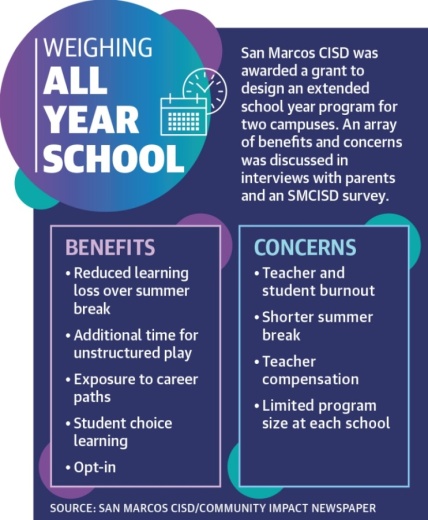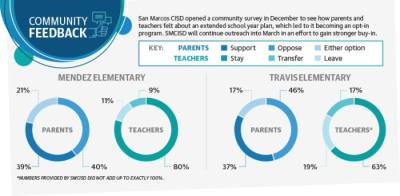District leaders spearheading the initiative say the schedule redesign is intended to reduce the loss of knowledge over a typical summer break, called the summer slide, while providing students with educational opportunities beyond what is available in a typical school year.
SMCISD was one of 11 Texas school districts selected to receive a $200,000 grant to develop such a program by the TEA, which refers to it as a full year redesign.
However, SMCISD officials are quick to note the designation is a bit of a misnomer, as students will still have a summer break, albeit an abbreviated one.
It is one of multiple alleged misconceptions the district hopes to address through community outreach, which Nicole Dray, SMCISD’s chief innovation officer, said has been hindered by the coronavirus pandemic.
“In non-COVID-19 times, the community outreach would be very much like invitation after invitation to come in person and engage with us in not just conversations, but design work at a much more interactive and intimate level,” Dray said. “That has been probably our most significant struggle. We’ve just not been able to engage with our families the way we would like to.”
The effect of Community Outreach
Cari Brown, who has two children enrolled at Mendez Elementary, said a lack of information was the principal reason she was on the fence about the program.
“I don't know enough about it at this point, other than the schedule, and I haven't heard any real compelling arguments for it aside from [diminishing] the summer slide,” she said.
Brown, who said she may have missed notifications of meetings under a deluge or other district messages related to the pandemic, expressed greater interest and openness to the program once learning it would require parents to opt-in.
“I like knowing that it's not mandatory, and I'm definitely interested in hearing more about the curriculum,” Brown said. “Honestly, probably what we'll do is let our kids decide if we're able to—if we can make it work with our schedules.”
Another Mendez Elementary parent, Valerie Gomez, was able to attend both a virtual and in-person meeting about the extended school year and said increased knowledge of the program fostered her support for it.
“Once I went to the meeting and got to meet with everybody, and got to ask my questions and talk about it, I was all for it,” Gomez said. “I’ve had a couple of other people too who just think it’s an extra 30 days, and then I explained how our meetings went and what we talked about, and then their whole mindset changes.”
The program’s design so far
Beginning with the 2021-22 school year, the calendar at Travis and Mendez will be extended by as many as 30 days of instruction for students opted into the program. During the 2019-20 school year, there were 173 days of instruction at both schools, according to the district’s grant application.
The program is allowed to include as many as 210 instructional days, and it will continue to be adjusted until a finalized plan is submitted to TEA on April 1. Community outreach will be ongoing until the school board considers approval March 5, Dray said.
If approved by the board and then the TEA, the new school year would begin in early August 2021 and end in late June 2022. Summer break would last a little longer than one month, a stark departure from SMCISD’s typical summer break lasting more than three months.
Other holidays and breaks would remain consistent with other district schools.
According to TEA’s website, the calendar redesign would change daily schedules by decreasing instruction time so it can be spread out over additional days while increasing time for planning and breaks during the day.
However, the reduced instruction time does not translate to a shorter school day, Dray said. More time would instead be devoted to activities such as unstructured play, physical education and activities promoting the development of extracurricular interests, called enrichment.
The plan also calls for half a day each week to be devoted to these enrichment activities, which are still being fleshed out by Dray and Blaine Carpenter, the district’s coordinator of school redesign.
He said enrichment could involve community partners visiting the schools to instruct students in a variety of subjects, and also exposing them to career paths.
“We're looking at all different kinds of arts, some music and dance, and painting, coding and cooking classes,” Carpenter said. “All kinds of activities that are in whole child development.“
The promise of more options
Enrichment activities have played a pivotal role in garnering support for the program from multiple parents, including Gomez, who said when Carpenter explained them it was a turning point for her perception of the extended school year.
Anthony Trevino, whose son attends Travis Elementary, said he is attracted to the program because of its added exposure to additional career paths.
“It's nice to be able to explore other options and see what else you could fall in love with,” Trevino said. “It gives them a chance to really open up and see what else is really out there in the world.”
The changes to the school’s teaching program would also include student choice assignments, which have already been implemented at SMCISD’s Bowie Elementary School. This approach empowers students to take a passion project approach to learning, according to Dray.
She said teachers can mold some assignments around a concept students express interest in, such as flight or aviation, and then assignments can be contextualised around that to promote engagement.
“When you allow the students to have choice, they’ll take their own learning further than a teacher following a typical scope and sequence,” Dray said. “Students will accelerate their own learning simply because they're so interested in it.”
Teachers would also see changes to their weekly schedules with additional time for planning and professional development, which would be scheduled throughout the year, as opposed to during the weeks leading up to the start of the fall semester.
Carpenter also said that, like students, teachers would not be forced to join the program and would instead be asked to opt in.
“We want to have the teachers in the program who really want to be there and really want to be involved,” Carpenter said. “For that cohort of students who opts in, we'd have teachers who are opting in as well.”
Contemplating a shorter summer
Parents also noted other concerns and benefits to a truncated summer such as scheduling conflicts and burnout.
Brown’s lingering concerns about the program focused on how the schedule of her elementary-level children, if they opted in, could interfere with her middle school son’s summer schedule. Her family’s summer travel could be limited to roughly one month of time off from the extended schedule.
Ultimately, Brown wanted the extended school year’s curriculum integrated into a standard school year.
“I wish they could do enrichment in a normal school year,” she said. “Especially at this age, they're already spending so much time learning toward those standardized tests that they're getting less P.E., art and music than we did when we were kids.”
Gomez saw the compact summer as less of an issue for her family, which takes vacations during off-peak times of the year.
Multiple parents also felt the extended school year would benefit them by reducing the amount of time they would have to pay for child care, as their children would be in school for a greater portion of the year.
Dray and Carpenter encouraged Travis and Mendez parents to voice their concerns and provide feedback during the community outreach phase. They said the decision to make the program opt in was in response to feedback from parents and staff.
“I just want to stress that we're really committed to stakeholder driven redesign so that it’s truly responsive to the needs of our kids in our community,” Dray said. “That’s the driving factor.”
Paying for the program
Two funding mechanisms are in place to cover the design and implementation of an extended school year, including additional compensation for staff at the same daily rate used during the standard school year, Carpenter said.
The $200,000 grant SMCISD was selected for in 2020 only covers the design of the program. If the district’s finalized plan is approved by the school board, it is then submitted to TEA by April 1 for review.
A second grant of $200,000 would be awarded to the district by TEA, pending approval of the program’s plan, and would be used to implement the extended school year.
In addition to the grants, Dray said the district would also receive average daily attendance funding at an adjusted rate through the grant, called Additional Days School Year, to go toward program expenses such as payroll.
According to a survey sent out by the district, some parents expressed concern about teacher compensation being insufficient.
Attempts to interview SMCISD teachers for this story were unsuccessful, but results from the district’s community survey illustrate where some teachers landed on the redesign.
At Travis Elementary, 17% of staff said they would transfer to another school, and 19% said they would leave the district if the extended school year was implemented for the entire campus. At Mendez Elementary, 9% said they would transfer to another school, and 11% said they would leave SMCISD if the redesign was campus-wide.
Brown said she was concerned about the burden put upon teachers, and how the extended school year could interfere with other compensation, such as summer jobs, despite the pay scale staying the same for the extra instructional days.
“I definitely want to take into consideration what's best for teachers, in addition to what's best for kids, because I think if the teachers aren't happy then the kids won’t be happy,” she said. “They deserve to be well taken care of—the teachers do, and staff and admins.”
Stephanie Tipton, another Mendez Elementary parent, expressed similar concerns about teacher compensation while also noting the increased pressure teachers have been under during the pandemic. Tipton said she would support increased compensation at the expense of increased taxes.
“After this year, seeing what teachers have gone through, just from friends that are teachers and my kid’s teachers, they definitely are not compensated fairly, in my opinion,” Tipton said. “They've gone above and beyond this year.”








